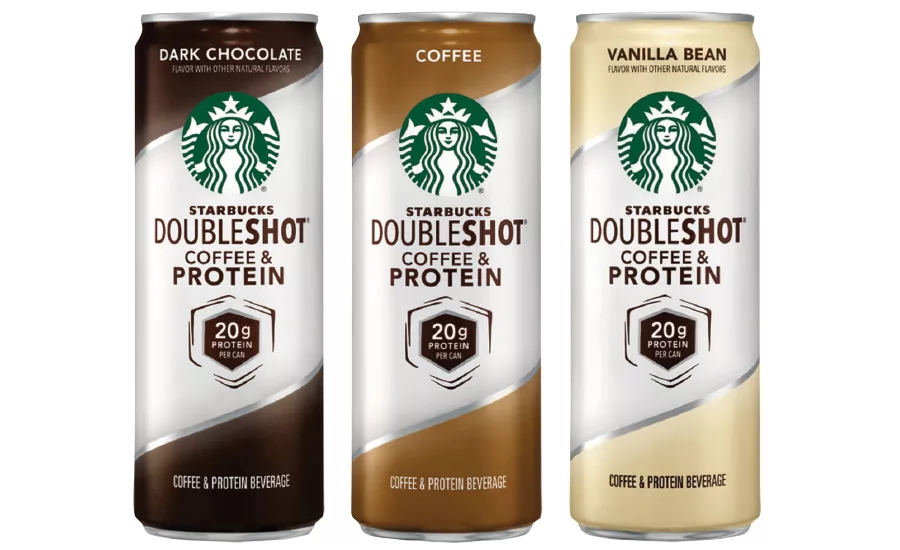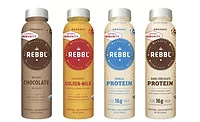Coffee flavors increase in functional, protein beverages
Use of coffee flavor driven by health and wellness

Synergy Flavors’ Kevin Goodner anticipates coffee protein beverages to flourish this year, noting the ingredient’s incorporation into more functional beverages. (Images courtesy of Starbucks Coffee Co.)

Thomas Jefferson was quoted as saying, “Coffee — the favorite drink of the civilized world.” Today, coffee remains a favorite beverage and flavor in the United States. As such, beverage-makers are using the flavor within a plethora of categories, including ready-to-drink (RTD) coffees, spirits and craft beers. As demand for better-for-you products continues, coffee is being used by beverage-makers in even more platforms.
Functional beverages are an area in which experts say coffee will play an integral role this year. “I believe coffee is going to make a big splash in the protein drink category this year,” says Kevin Goodner, product manager of essences and extracts at Synergy Flavors, Hamilton, Ohio. “It has been building for a while, and I think this year will see significant growth. This is due to several things, like consumers’ continued demand for protein products and also the great flavor combination. Coffee can act as a great ‘masking agent’ for flavor offnotes that sometimes are associated with protein beverages. Also given the popularity of coffee with milk products (cappuccino, lattes, frappes, iced coffees, etc.), pairing coffee with a dairy-protein beverage is a ‘no-brainer.’
“The nutrition space is always looking for good flavors to work with both plant- and dairy-based proteins, and with vanilla and chocolate ‘done,’ coffee is the next obvious choice,” he continues.
Florham Park, N.J.-based Finlay Tea Solutions US Inc.’s Senior Marketing Coordinator Stacy DeMars also notes the progression of coffee into the functional space. “Overall health-and-wellness trends are impacting the use of coffee ingredients in beverages,” she says. “Products such as functional beverages, energy drinks, even juice products are adding coffee to their portfolios.”
She explains that continued interest in overall health has helped to boost the sales of nutritional, performance, functional and protein drinks. “These health-and-wellness beverages are ideal markets to utilize both coffee and tea ingredients for health benefits, particularly when consumers are looking for additional flavor options aside from chocolate or vanilla, which are typically associated with these kinds of drinks,” she says.
Bill Graham, vice president of sales for North America at Prova Inc., Danver, Mass., notes that coffee will continue to move into non-traditional categories. “Maybe you’ll see coffee water, I don’t know that, but people are going to drink coffee water that drink coffee,” he says. “People are looking for good flavor.”
Finding flavor
The popularity of coffee’s flavor is one benefit when used in functional beverages. “This flavor itself is a popular flavor,” Graham says. “Today, a lot more good-for-you-type beverages are being developed for more value-added [benefits], versus a carbonated beverage. So, what’s happening is coffee is a product that has caffeine in it, so it’s considered an energizer. It can also be considered for weight loss because of the caffeine — it gets your metabolism going. I think what’s happening is you have a lot of active ingredients, sometimes the bitterness of the coffee will blend nicely with the ingredients that are being used.”
Finlay’s DeMars echoes similar sentiments. “Coffee and tea are some of the most consumed beverages in the world, not only are they natural ingredients that can offer great flavor, healthy polyphenols and antioxidants, coffee and tea appeal to a large number of consumers who already are drinking them, making it an easy transition to be used in a variety of beverage applications, like energy drinks and wellness beverages,” she says.
When incorporating coffee into a beverage formulation, taste is an important factor, Synergy Flavors’ Goodner adds. “How well does the product represent a fresh-brewed cup of coffee? Ingredient statement is important today with clean-label demands. Ideally you want a 100-percent-coffee product that provides that ‘first cup of coffee flavor,’” he explains. “In reality, everything else can be worked around (caffeine content, bitterness, roast level, etc.), but if your ingredient isn’t delivering on the fresh-brewed character while being 100 percent coffee, your customer isn’t going to respond as well as they could.”
Finding the right coffee source also is crucial. “Using the wrong type of coffee seems to be the biggest challenge. Knowing your final application, cost parameters, processing limitations and what attributes you really want from the coffee are integral to delivering the right product for the job,” explains Sue Maiocchi, product optimization manager at S&D Coffee & Tea, Concord, N.C.
She adds that different coffee varietals will offer different sensory attributes, such as aroma, acidity, sweetness, mouthfeel and flavor. “Depending on the delivery system and the application, some of the attributes are more noticeable than others,” she says. “Manufacturers vary in what they are looking for depending on the final application.”
Prova’s Graham notes Arabica coffee offers more flavor, is slow-grown at higher altitudes, is hand-picked and has lower caffeine content than Robusta. Robusta coffee, however, offers less flavor, is fast-grown at a lower altitude and is harvested by machines, he says.
Niles, Ill.-based Imbibe’s Senior Beverage Scientist Hillary Sandrock explains that three factors attribute to the flavor composition of coffee — regional origin, roast degree and brewing technique. “Coffees from Central and South America are characterized by a bright acidity and floral, fruity or nutty flavors,” she explains. “African coffees tend toward deep berry or tropical fruit notes, and Indonesian coffees frequently have earthy, woody flavors with very low acidity and a heavier body. As coffee is roasted darker, however, the origin character gets eclipsed by the roast character. … Roast degree may have more of an impact on a finished beverage, since smoky phenolic compounds like guaiacol, which are associated with dark roast coffees, are a stronger flavor and often more noticeable amidst other beverage ingredients than some of the more nuanced origin notes.”
Perfecting the brew
Although finding the right flavor is critical, other factors, such as pH, also can play a role in a beverage-maker’s formulation, according to Prova’s Application Lab Manager Marie Lebeller.
“The problem with coffee is that usually the pH is acidic, so the pH is low,” she explains. “And when you put coffee in a dairy beverage it will curdle because the pH of the milk is neutral.”
Even though varying pH levels can be an issue, she adds that there are alternatives. She notes using natural flavors, or essences that don’t contain coffee and have a neutral pH, as possible solutions.
Imbibe’s Sandrock highlights that coffee can be particularly challenging when working with dairy proteins. “Since coffee is acidic, it can cause precipitation of dairy proteins during heat treatment. Using buffers to control the product’s pH can help with stability,” she says.
Synergy Flavors’ Goodner notes that maintaining the quality of coffee ingredients is another challenge. “Coffee ingredients can be difficult to work with because the flavor compounds (often over 300) can be susceptible to oxidation, and if you are not handling or storing your product carefully, you can significantly degrade the quality of your ingredient and thus your final product,” he says. “This can affect storage, handling, processing and even down to things like working with your supply chain to unitize the product so that all of the product in a container is used in a batch.”
He adds that this can be overcome in multiple ways, starting with how the supplier handles the product and extending to how the customer handles it.
Looking for a reprint of this article?
From high-res PDFs to custom plaques, order your copy today!



